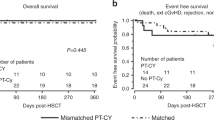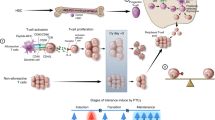Abstract
Allogeneic blood or marrow transplantation (BMT) is potentially curative for a variety of life-threatening nonmalignant hematologic diseases such as paroxysmal nocturnal hemoglobinuria (PNH) and hemoglobinopathies. The application of BMT to treat these disorders is limited by the lack of suitable donors and often end-organ damage from the underlying disease. We treated three patients with thrombotic PNH, one of whom also had sickle cell disease, with a nonmyeloablative, HLA-haploidentical BMT with post-transplant CY. Rapid engraftment without GVHD occurred in two of the patients, including the patient with sickle cell disease. Both patients are disease free with full donor chimerism and require no immunosuppressive therapy, with follow-up of 1 and 4 years, respectively. Nonmyeloablative, HLA-haploidentical BMT with post-transplant CY is a promising approach for patients with life-threatening nonmalignant hematologic disease who lack an HLA-matched sibling donor.
This is a preview of subscription content, access via your institution
Access options
Subscribe to this journal
Receive 12 print issues and online access
$259.00 per year
only $21.58 per issue
Buy this article
- Purchase on Springer Link
- Instant access to full article PDF
Prices may be subject to local taxes which are calculated during checkout




Similar content being viewed by others
References
Panepinto JA, Walters MC, Carreras J, Marsh J, Bredeson CN, Gale RP et al. Matched-related donor transplantation for sickle cell disease: report from the center for international blood and transplant research. Br J Haematol 2007; 137: 479–485.
Bernaudin F, Socie G, Kuentz M, Chevret S, Duval M, Bertrand Y et al. Long-term results of related myeloablative stem-cell transplantation to cure sickle cell disease. Blood 2007; 110: 2749–2756.
Takahashi Y, McCoy Jr JP, Carvallo C, Rivera C, Igarashi T, Srinivasan R et al. In vitro and in vivo evidence of PNH cell sensitivity to immune attack after nonmyeloablative allogeneic hematopoietic cell transplantation. Blood 2004; 103: 1383–1390.
van BK, Bartholomew A, Stock W, Peace D, Devine S, Sher D et al. Fludarabine-based conditioning for allogeneic transplantation in adults with sickle cell disease. Bone Marrow Transplant 2000; 26: 445–449.
Iannone R, Casella JF, Fuchs EJ, Chen AR, Jones RJ, Woolfrey A et al. Results of minimally toxic nonmyeloablative transplantation in patients with sickle cell anemia and beta-thalassemia. Biol Blood Marrow Transplant 2003; 9: 519–528.
Horan JT, Liesveld JL, Fenton P, Blumberg N, Walters MC . Hematopoietic stem cell transplantation for multiply transfused patients with sickle cell disease and thalassemia after low-dose total body irradiation, fludarabine, and rabbit anti-thymocyte globulin. Bone Marrow Transplant 2005; 35: 171–177.
Mentzer WC, Heller S, Pearle PR, Hackney E, Vichinsky E . Availability of related donors for bone marrow transplantation in sickle cell anemia. Am J Pediatr Hematol Oncol 1994; 16: 27–29.
Adamkiewicz TV, Szabolcs P, Haight A, Baker KS, Staba S, Kedar A et al. Unrelated cord blood transplantation in children with sickle cell disease: review of four-center experience. Pediatr Transplant 2007; 11: 641–644.
Walters MC . Cord blood transplantation for sickle cell anemia: bust or boom? Pediatr Transplant 2007; 11: 582–583.
O'Donnell PV, Luznik L, Symons H, Jones RJ, Gooley T, Harrington E et al. Favorable outcome of patients with relapsed Hodgkin lymphoma after nonmyeloablative hematopoietic cell transplantation using related haploidentical donors. Blood 2006; 108: 894a–895a.
O'Donnell PV, Luznik L, Jones RJ, Vogelsang GB, Leffell MS, Phelps M et al. Nonmyeloablative bone marrow transplantation from partially HLA-mismatched related donors using post transplantation cyclophosphamide. Biol Blood Marrow Transplant 2002; 8: 377–386.
Crescenzi B, Fizzotti M, Piattoni S, La SR, Matteucci C, Carotti A et al. Interphase FISH for Y chromosome, VNTR polymorphisms, and RT-PCR for BCR-ABL in the monitoring of HLA-matched and mismatched transplants. Cancer Genet Cytogenet 2000; 120: 25–29.
Aaltonen LA, Peltomaki P, Leach FS, Sistonen P, Pylkkanen L, Mecklin JP et al. Clues to the pathogenesis of familial colorectal cancer. Science 1993; 260: 812–816.
Sreenan JJ, Pettay JD, Tbakhi A, Totos G, Sandhaus LM, Miller ML et al. The use of amplified variable number of tandem repeats (VNTR) in the detection of chimerism following bone marrow transplantation. A comparison with restriction fragment length polymorphism (RFLP) by Southern blotting. Am J Clin Pathol 1997; 107: 292–298.
Van Deerlin VM, Leonard DG . Bone marrow engraftment analysis after allogeneic bone marrow transplantation. Clin Lab Med 2000; 20: 197–225.
Brodsky RA, Sensenbrenner LL, Jones RJ . Complete remission in acquired severe aplastic anemia following high-dose cyclophosphamide. Blood 1996; 87: 491–494.
Brodsky RA, Petri M, Smith BD, Seifter EJ, Spivak JL, Styler M et al. Immunoablative high-dose cyclophosphamide without stem cell rescue for refractory severe autoimmune disease. Ann Intern Med 1998; 129: 1031–1035.
Brodsky RA, Sensenbrenner LL, Smith BD, Dorr D, Seaman PJ, Karp JE et al. Durable treatment-free remission following high-dose cyclophosphamide for previously untreated severe aplastic anemia. Ann Intern Med 2001; 135: 477–483.
Brodsky RA, Fuller AK, Ratner LE, Leffell MS, Jones RJ . Elimination of alloantibodies by immunoablative high-dose cyclophosphamide. Transplantation 2001; 71: 482–484.
Hilton J . Role of aldehyde dehydrogenase in cyclophosphamide-resistant L1210 leukemia. Cancer Res 1984; 44: 5156–5160.
Jones RJ, Barber JP, Vala MS, Collector MI, Kaufmann SH, Ludeman SM et al. Assessment of aldehyde dehydrogenase in viable cells. Blood 1995; 85: 2742–2746.
Mayumi H, Umesue M, Nomoto K . Cyclophosphamide-induced immunological tolerance: an overview. Immunobiology 1996; 195: 129.
Nomoto K, Eto M, Yanaga K, Nishimura Y, Maeda T . Interference with cyclophosphamide-induced skin allograft tolerance by cyclosporin A. J Immunol 1992; 149: 2668–2674.
Hillmen P, Young NS, Schubert J, Brodsky RA, Socie G, Muus P et al. The complement inhibitor eculizumab in paroxysmal nocturnal hemoglobinuria. N Engl J Med 2006; 355: 1233–1243.
Brodsky RA, Young NS, Antonioli E, Risitano AM, Schrezenmeier H, Schubert J et al. Multicenter phase 3 study of the complement inhibitor eculizumab for the treatment of patients with paroxysmal nocturnal hemoglobinuria. Blood 2008; 111: 1840–1847.
Rother RP, Rollins SA, Mojcik CF, Brodsky RA, Bell L . Discovery and development of the complement inhibitor eculizumab for the treatment of paroxysmal nocturnal hemoglobinuria. Nat Biotechnol 2007; 25: 1256–1264.
Author information
Authors and Affiliations
Corresponding author
Rights and permissions
About this article
Cite this article
Brodsky, R., Luznik, L., Bolaños-Meade, J. et al. Reduced intensity HLA-haploidentical BMT with post transplantation cyclophosphamide in nonmalignant hematologic diseases. Bone Marrow Transplant 42, 523–527 (2008). https://doi.org/10.1038/bmt.2008.203
Received:
Revised:
Accepted:
Published:
Issue Date:
DOI: https://doi.org/10.1038/bmt.2008.203
Keywords
This article is cited by
-
Autologous stem cell transplantation in adult patients with intermediate-risk acute myeloid leukemia in first complete remission and no detectable minimal residual disease. A comparative retrospective study with haploidentical transplants of the global committee and the ALWP of the EBMT
Bone Marrow Transplantation (2023)
-
Pre-transplant myeloid and immune suppression, upfront plerixafor mobilization and post-transplant cyclophosphamide: novel strategy for haploidentical transplant in sickle cell disease
Bone Marrow Transplantation (2021)
-
Correction of murine sickle cell disease by allogeneic haematopoietic cell transplantation with anti-3rd party veto cells
Bone Marrow Transplantation (2021)
-
Haploidentical Hematopoietic Cell Transplantation Using Post-transplant Cyclophosphamide for Children with Non-malignant Diseases
Journal of Clinical Immunology (2021)
-
Impact of mother donor, peripheral blood stem cells and measurable residual disease on outcomes after haploidentical hematopoietic cell transplantation with post-transplant cyclophosphamide in children with acute leukaemia
Bone Marrow Transplantation (2021)



